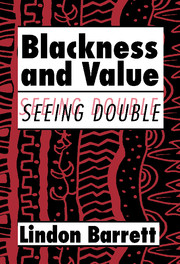Book contents
- Frontmatter
- Contents
- Acknowledgments
- Introduction: “In the Dark”
- Part One Violence and the Unsightly
- Part Two Reasonings and Reasonablenesses
- Part Three Phonic and Scopic Economies
- 5 Signs of Others: Circulations of a Purloined Letter Understood Otherwise
- 6 Signs of the Visible: (Re) Moving Pictures in The Narrows
- Notes
- Bibliography
- Index
6 - Signs of the Visible: (Re) Moving Pictures in The Narrows
Published online by Cambridge University Press: 18 December 2009
- Frontmatter
- Contents
- Acknowledgments
- Introduction: “In the Dark”
- Part One Violence and the Unsightly
- Part Two Reasonings and Reasonablenesses
- Part Three Phonic and Scopic Economies
- 5 Signs of Others: Circulations of a Purloined Letter Understood Otherwise
- 6 Signs of the Visible: (Re) Moving Pictures in The Narrows
- Notes
- Bibliography
- Index
Summary
The film scholar Anne Friedberg and the historian Donald Lowe in separate projects argue for the paramount role of the scopic as a cultural imperative in the social and epistemological systems of the modern West. Concerned in History of Bourgeois Perception with “the society of Western Europe, especially Britain and France, from the last third of the eighteenth to the first decade of the twentieth century” (17), Lowe claims that the ascendancy of typographic media and the scopic define the dominant field of perception for this period then are extrapolated into the historical period after 1910. The typographic, the scopic, and “the epistemic order of development-in-time” (17), Lowe argues, define the nature of perception and come to stand for the rational. In Window Shopping: Cinema and the Postmodern, Anne Friedberg argues that modern and postmodern subjectivity emerged in terms of “the increased centrality of the mobilized and virtual gaze as a fundamental feature of everyday life” (4). Defining the virtual gaze as “a received perception mediated through representation” and the mobilized gaze as any “that travels … through an imaginary elsewhere and an imaginary else when” (2; emphasis in original), Friedberg details how particular organizations of looking are fundamental to constructing social subjectivity in “late eighteenth- and early nineteenth-century industrialization and urbanization” (13) and, as Lowe does, in the cultural order proceeding from that period. Both studies propose that a politics and socialization of looking are rudimentary to the establishment and culture of the modern West. No matter how seemingly sedimented in the fabric of the quotidian and, therefore, seemingly beyond political instrumentation, the “interestedness” and “resourcefulness” of the scopic are overwhelming.
- Type
- Chapter
- Information
- Blackness and ValueSeeing Double, pp. 214 - 242Publisher: Cambridge University PressPrint publication year: 1998



